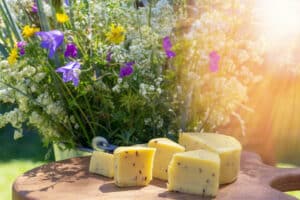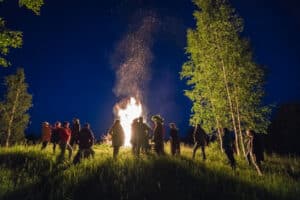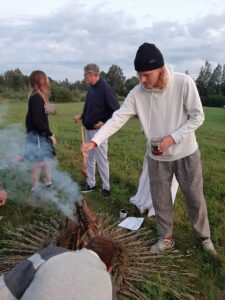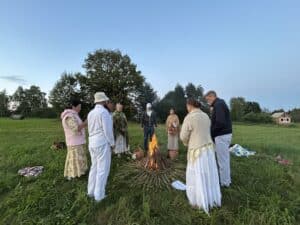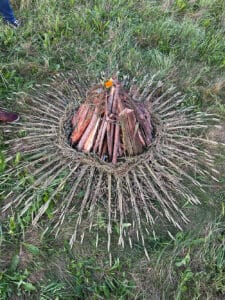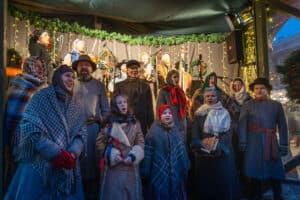Latvian holidays are steeped in ancient pagan tradition. Most important are the winter and summer solstices. Connections with the ancient past are thought to be the most authentic connections with being Latvian. Other major holidays celebrate the hard-won independence and sovereignty of Latvia. Soviet influence, especially as compared to other former Soviet republics, is minimal, showing a near complete rejection of Soviet culture. Nearly all holidays are associated with songs known as dainas and traditional dances. For more on Latvian history, see this article at our sister site, GeoHistory.today.
Days Off
Long Weekends and Extra Days Off by Semester in 2026
| Spring | Summer | Fall | Winter |
| April 18-21 May 1, 4 |
June 23-24 November 23 |
November 18 | December 24-26, 31 January 1 |
New Year’s Eve and New Year’s Day
In Latvian: Vecgada vakars and Jaungada diena
December 31, 2025 – January 1, 2026
Public holiday
Most Latvian cities host large firework celebrations over their main squares, which are filled with revelry until dawn. However, for Latvians, the New Year (Jaunais gads) is a relatively laid-back start to the year.
New Year’s in Latvia gained in popularity under the Soviets, who encouraged its celebration and suppressed the winter solstice, one of Latvia’s main cultural events, as part of a wider effort to stamp out “superstition” and religion. Many solstice traditions were preserved by marking them on New Year’s and, although the solstice is again freely celebrated today, many of those folk traditions remain associated with New Year’s. For instance, one’s house should be cleaned to rid it of bad energy and start the year fresh. One must be awake at midnight — otherwise, one risks sleeping the year away. Perhaps the most unique tradition, called laimes liešana, molten lead is poured into water, and the resulting shape reveals one’s fortune for the new year. There is even an app to simulate the tradition if you are without lead for the New Year.
Traditional foods for the holiday include gray peas and bacon, Latvia’s national dish. Folklore says that the peas symbolize the tears of the coming year and, if they are all eaten by midnight, none will be left to shed in the new year. Fish is also common, the scales of which can be put in one’s wallet to attract money in the new year. Most importantly, the table must contain a lot of food, and especially rich foods, to bring abundance in the coming year. Speķrauši, which are small, crescent-shaped pies stuffed with bacon and onion, are very common, as is roast pork.
Television traditions from Soviet rule remain. For those at home, annual variety shows and old movies are aired, to be played in the background of celebratory gatherings. The president makes a midnight televised toast to the nation, after which everyone raises a celebratory glass.
Meteņi
Feb 6, 2026
Moveable Date
Not a public holiday
Meteņi marks the midpoint between the winter solstice and the spring equinox. Ancient Latvians celebrated the date as the New Year and as an expectation of spring. With Christianity, the pagan celebration was officially tied to the day before Lent and eventually fell from favor. Today it is making a small comeback, celebrated in some schools as a way of teaching children about their ancient heritage. In this way, children are starting to bring the holiday back into families. The word “Meteņi” originates from the early Latvian word “meti,” meaning “turn of time,” which still forms the basis of the Latvian word “metai” (year).
Meteņi activities are tied to charity, good fortunes, and good harvests. Sledding and traveling can both serve as good omens – with speed and distance playing in one’s favor. The Latvian winter masquerade tradition, ķekatas (also called budēļi) has its finale on this day. People dress as spirits and roam from house to house, singing, dancing, and demanding food and perhaps even playing small tricks along the way.
Below is a Latvian-language report on a modern celebration of the holiday showing many traditions from sledding, snow-tackling, swinging in a sack, and lots of song and music. Read more about Meteņi and other spring celebrations here.
International Women’s Day
In Latvian: Starptautiskā sieviešu diena
March 8, 2026
Not a public holiday
International Women’s Day is a holiday celebrated across Europe but has always had political implications associated with women’s rights to work and socialist ideology. In Latvia, it was celebrated as an official state holiday under the Soviets but dropped from the calendar with independence. It remains, however, in the national consciousness. For most it is a day when women must be recognized with tulips, chocolates, and kind words, although for some it is a day to deride those still celebrating a holiday promoted by a dead regime.
Good Friday, Holy Friday
In Latvian: Lielā Piektdiena, Svētā Piektdiena
April 3, 2026
Moveable Friday
Public holiday
Good Friday, commemorating Christ’s death before his Easter resurrection, is a public holiday in many European countries. While the majority of Latvia identifies as Lutheran, Catholic, or Orthodox, Latvia is also one of Europe’s most secular and least actively religious states. Thus, while special church services are held on this day, for most Latvians, this day is most important as the beginning of a four-day weekend often spent connecting with nature and enjoying the warmer weather with picnics and hikes. It’s also often used as a day to start preparations for Easter (the spring equinox): dying eggs, preparing cheese, and baking breads.
Easter Sunday and Monday
In Latvian: Lieldienas and Otrās Lieldienas
April 5-6, 2026
Moveable Sunday and Monday
Public holiday
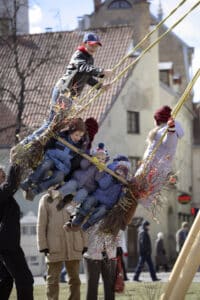
In Latvian, the word for Easter, “Lieldienas” literally translates to “Big Day” and originally referred to a major pagan festival celebrating the equinox. When Christianity came, Latvians kept the name and their traditions, but allowed the date to be moved slightly. Latvian Easter celebrations mix pagan imagery of the sun’s return, of the victory of light over dark and life over death, with that of Jesus’ resurrection.
Decorating eggs, which symbolize the sun, life, and fertility, is an old and popular Latvian Easter tradition. Natural materials are used to create a range of colors: onion skins are used for yellow, brown, or purple; bilberry jam for blue; red cabbage for red or purple; and pine needles for green. Eggs wrapped in leaves, flowers, or strings before being dyed will have patterns left on them.
Dyed eggs are used in olu ripināšana, a game in which eggs are rolled down a slanted board. Like marbles, if a player’s egg touches an egg already at the bottom of the board, that player takes both eggs. Other games include olu meklēšana, or egg hunt, and kaušanās ar olām, an egg fighting game in which players strike their eggs together to see which is the strongest.
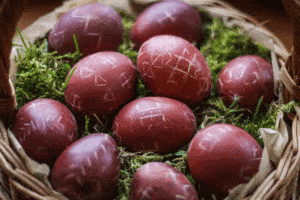
In Latvian mythology, birds often symbolize evil, sickness, and the last vestiges of winter. The Lieldienas tradition of chasing birds away is said to dispel sickness for the following year or drive off the last of winter and welcome in the summer. Swinging, preferably on a high swing built on a tall hill and early in the morning on Lieldienas can also encourage the sun to keep rising, bring you health, and even prevent summer mosquito bites.
The most traditionally Latvian food for the day is the pantāgs, an omelet that one ritually spices as a way of making a wish for the coming year. Lieldienu siers, which means “Easter cheese,” was borrowed from the slavic paskha and is made of cottage cheese, eggs, and butter, and can include dried fruit or slivered almonds. Lieldienu maize, or “Easter bread,” was originally borrowed from the Slavic kulich but now varies heavily in Latvia. Usually, it’s a brioche bread, often with dried fruit, powdered sugar, or a filling made from fruit and/or cottage cheese. These dishes are quite similar to and, two dishes enjoyed in Russia and Ukraine for Orthodox Easter.
Easter Monday is “Otrās Lieldienas,” or “Second Big Day.” While church events are held on this day, most Latvians use it for relaxing, preferably outdoors.
Labor Day and Constitution Day
In Latvian: Darba svētki; Latvijas Republikas Satversmes sapulces sasaukšanas diena
May 1, 2026
Public holiday
May 1 is a double holiday in Latvia. First, it is Labor Day, as celebrated in many countries. In Latvia, it is also the anniversary of the first meeting of the 1920 Constitutional Assembly of the Republic of Latvia that gave Latvia its first democratic constitution. For most, however, it is primarily a day for rest and enjoying the late spring weather with hikes, picnics, and concerts.
Restoration of Independence Day
In Latvian: Latvijas Republikas Neatkarības atjaunošanas diena
May 4, 2026
Public holiday
Latvia has two Independence Days. May 4 is the anniversary of Latvia’s 1990 declaration of independence following occupation by the Soviet Union for 50 years. On this day, the Supreme Council of the Soviet Socialist Republic of Latvia reinstituted the 1922 Constitution of the Republic of Latvia, which remains in effect today. The council’s declaration states that Latvia had been sovereign throughout the occupation and emphasized that more than 50 countries never recognized the USSR’s annexation of Latvia.
This holiday is marked with speeches and parades, including a military parade hosted by a different city each year. People gather for dinners featuring traditional foods served on white tablecloths, symbolic of national pride and unity.
The other Independence Day is on November 18.
Ūsiņi
In Latvian: Ūsiņi/Ūsiņdiena
May 10, 2026
Not a public holiday
Ūsiņi is a pagan holiday that has largely disappeared. However, but is sometimes marked in Latvian classrooms to teach children about their ancient heritage and is thus beginning to make some inroads back into Latvian households. Marking the beginning of summer and the midpoint between the spring equinox and summer solstice, it is devoted to Ūsiņš, whose name means “whiskers,” and who is a god of light and horses in Latvian mythology. The day is when horses were put out to pasture for the summer. Eggs, symbolic of the sun, are also traditional, especially in eating pantāgs, an omelet that one ritually spices as a way of making a wish for the coming year, and placing eggs in hollow oaks as an offering for health for the horses in the coming year.
Below is a brief video on how the holiday was celebrated in the village of Druviena, Latvia in 2015.
Līgo and Jāņi
June 23 and 24, 2026
Public holiday
Līgo and Jāņi celebrate the summer solstice and represent one of the two biggest holidays on the Latvian calendar (the other is the winter solstice). “Līgo” is an old word referring to a swaying action and might refer to the fact that the personification of the holiday, a young man named Jānis, is typically depicted as arriving on a horse (on which the rider will naturally sway a bit). Sometimes Jānis is also depicted as a representative of or personification of the sun. Jānis is today also a popular given name for Latvians.
The summer solstice, known as “Vasaras saulgrieži” in Latvian, is the longest day of the year. In Latvia, in the far north, this means that it gets dark around midnight and the sun rises again around 3:30am. Latvians stay up all night on Līgo to sing, eat, drink, and the greet the rising sun on Jāņi.
Today, the holiday is celebrated as an expression of Latvian identity. Copious amounts of traditional foods, especially meats, beer, and Jani cheese (the later made only for this holiday) and prepared. Giant bonfires are lit and many dainas are sung.
For much more on this important holiday, see this article on our site.
Māras
August 15, 2026
Not a public holiday
Māras is the midpoint between the summer solstice and the autumn equinox and marks the beginning of autumn. It honors Māra, the Goddess of the Earth and protector of women. With the advent of Christianity, the date was moved to coincide with the celebration of Mary’s ascension into heaven.
Miķeļi
September 29, 2026
Not a public holiday
This autumn equinox celebration was originally called “Apjumības” and honored Jumis, god of the fields, grain, and grapes. With the advent of Christianity, the festival was renamed and moved to coincide with the Christian feast of St. Michael. The tradition of celebrating the year’s harvest, remains, however. In Riga, there is an annual Miķeļi farmers market in Dome Square that offers a bounty of local produce.
Mārtiņi
In Latvian: Mārtiņi/Mārtiņdiena
November 10, 2026
Not a public holiday
Mārtiņi marks the beginning of winter, when the harvest is over and livestock are brought into barns for the winter. This festival is named for Mārtiņš, a deity who protects horses during the long winter months, taking over from Ūsiņš, the patron deity of horses during the summer months (celebrated on May 10). Mārtiņi also marks the beginning of the masquerade (ķekatas or budēļi) season, which runs until February 6. Revelers will don disguises and visit their neighbors to bring good fortune and banish evil spirits, singing and dancing the whole time. At their neighbors’ homes, the masqueraders are met with food, drink, and more singing!
Latvian Freedom Fighters’ Remembrance Day
In Latvian: Lāčplēša diena
November 11, 2026
Not a public holiday
This annual remembrance honors those who died fighting in Latvia’s War of Independence from 1918-1920. November 11 marks the anniversary of the Battle of Riga, when the Latvians scored a major victory against the Russian army. The day is celebrated by wearing a red and white ribbon pinned in the shape of a “V,” for “victory,” over one’s heart. Military parades are held and a public march is held along the 11th of November Embankment to Riga Castle to leave candles in honor of the fallen. A major holiday under the First Latvian Republic, it was banned under the Soviets. It was first revived in 1988 under glasnost and the Third Latvian Awakening as a major challenge to Soviet rule and as a major step in building momentum to declare independence again.
Below is a video of the procession and following concert as marked in 2019.
Proclamation Day of the Republic of Latvia
In Latvian: Latvijas Republikas proklamēšanas diena
November 18, 2026
Public holiday
Latvia has two Independence Days. This one celebrates the day in 1918 in which the People’s Council of Latvia proclaimed the independence of Latvia for the first time. Before this, it had been ruled by German crusaders, Poland, Sweden, and Russia. Latvia then had to fight a war that lasted until 1920, when both the Germans and Russians were pushed off Latvian territory, before the independence could be fully enjoyed. The day is celebrated with concerts, military parades, and speeches across the country. In the Latvian capital, Riga, thousands of people participate in an annual torchlight procession, which proceeds from the statue of Kārlis Ulmanis, who was in 1918 elected the first leader of Latvia’s fledgling government, to the Freedom Monument, constructed in honor of those killed in the War of Independence.
Christmas Eve and Day
In Latvian: Ziemassvētku vakars, Ziemassvētki, Otrie Ziemassvētki
December 24, 25 and 26, 2026
Public holiday
Ziemassvētki marks the winter solstice and is Latvia’s second major calendar event. As with many holidays in Latvia, the date was moved when Christianity arrived – but the name and traditions largely stayed the same. “Ziemassvētki” translates to “Winter Festival” and the appropriate greeting on this day is “Priecīgus Ziemassvētkus!” (Happy Winter Festival).
Some believe that the Christmas tree may have originated in Latvia, where it is known as Ziemassvētku egle. Another common decoration is the puzurs, geometric shapes formed with sticks or straw and hung to catch bad energy that may have collected in the house. This tradition is common in the Baltics and Eastern Europe. The more complex a puzurs, the more effective it will be.
In Latvia, Christmas is celebrated across three days: Christmas Eve, Christmas, and Second Christmas. Christmas Eve is usually the main event, with dinner being the main tradition. Some families hold that there must be nine dishes on the table, others believe twelve. In either case, the table should be laden with a feast bigger than the group can eat. Grey peas, beer, speķrauši (bread rolls filled with bacon), sauerkraut, and roast pork and/or carp are all associated with the holiday.
As the winter solstice is the shortest day of the year, it is believed that on this day, the world of the dead is closest to our own. Thus, a pagan tradition still observed by some is to leave the food on the table overnight for any ancestors who may visit. Other traditions focus on dispelling bad energy and working to bring light back to the world. Dragging a yule log, or bluķa vilkšana, is one such custom. The heavier the log and the further it is dragged, the better. Its final resting place is usually together with other dragged logs from other families, which are then lit into a bonfire to call back the sun and begin another year anew with a fresh start.
Latvia’s ķekatas/budēļi masquerade tradition is also used to dispel bad energy. People, often in grotesque costumes, parade from house to house singing and dancing, their performances rewarded with gifts from the table.
As in most Western traditions, Latvian children are visited by a mythical bearded man bearing presents. He is known as Ziemassvētku vecītis (literally, Winter Festival Old Man) . Gifts are generally exchanged for Ziemassvētku, however, they are most usually small and symbolic and the receiver is expected to sing or recite a poem in return.
Christmas Day and Second Christmas are also filled with food, family, and song. However, they tend to be much more relaxed. There are also religious ceremonies held throughout the three days, but for most Latvians, the focus of Ziemassvētku is family and traditions connected with ancient culture and the natural world.
You Might Also Like

Latvia’s Līgo: A Midsummer Tradition That Outlived Empires
Līgo is the most important of Latvia’s national holidays. Marking the summer solstice and rooted in pre-Christian pagan traditions, it began as an ancient ritual to secure a good harvest and help communities endure the long, harsh Lativan winter. Despite centuries of foreign occupation and efforts by both Catholic and Soviet authorities to suppress it, […]
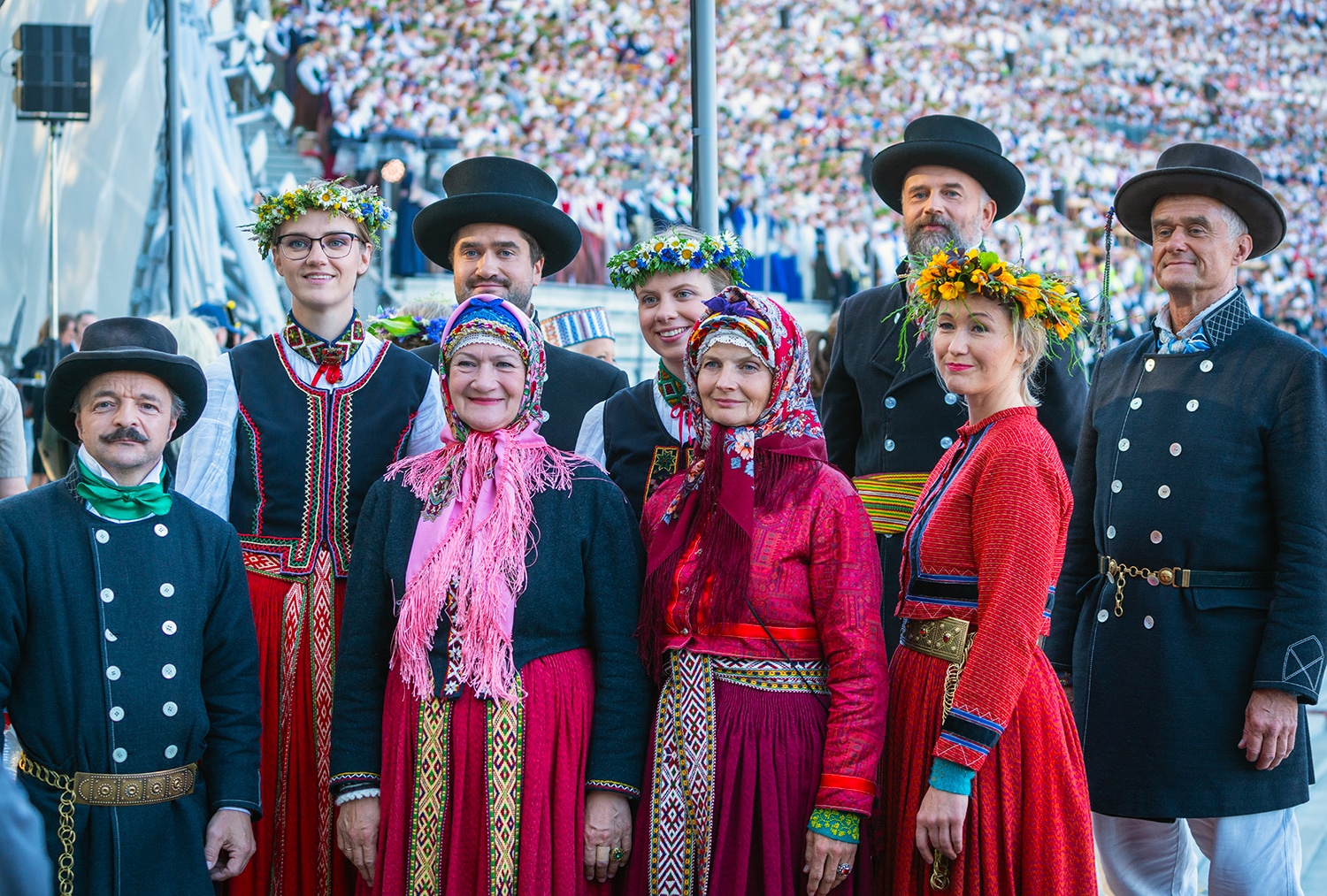
The Talking Latvian Phrasebook
The Talking Phrasebook Series presents useful phrases and words in side-by-side translation and with audio files specifically geared to help students work on listening skills and pronunciation. Below, you will find several useful phrases and words. To the left is the English and to the far right is the Latvian translation. In the center column […]

Latvian Holidays 2026: A Complete Guide
Latvian holidays are steeped in ancient pagan tradition. Most important are the winter and summer solstices. Connections with the ancient past are thought to be the most authentic connections with being Latvian. Other major holidays celebrate the hard-won independence and sovereignty of Latvia. Soviet influence, especially as compared to other former Soviet republics, is minimal, […]
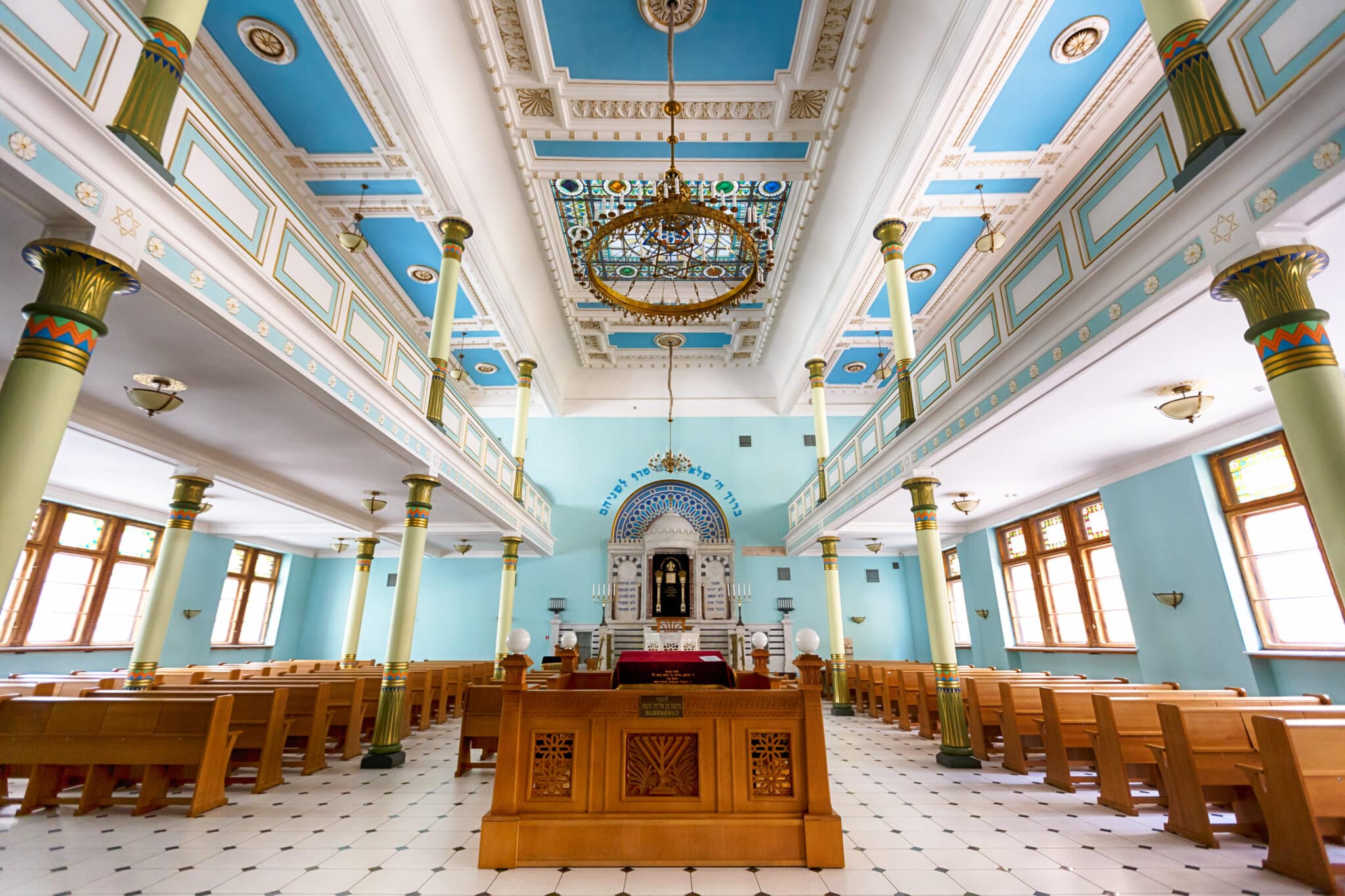
Jewish Latvia: A Brief History and Guide
This guide offers advice to Jewish students considering study abroad programs in Latvia. Here, you’ll read about the local Jewish history, Latvia’s active synagogues, staying kosher, and about some of Riga’s major Jewish cultural organizations, museums, and memorials. Most importantly, we’ll get you on your way to engaging with the local Jewish community and comfortably […]

Olivier and Rasols Salads: Holiday Traditions With Fascinating Histories
Russia’s Olivier Salad (Салат «Оливье») and Latvia’s rasols are well-known staples of their respective cuisines and common additions to holiday tables. Today, the recipes for both are quite similar, with chopped vegetables, egg, and meat dressed with mayonnaise. Olivier is now eaten throughout the former USSR and has even become common as “Russian Salad” in […]

